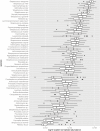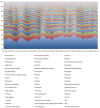Functional expression of dental plaque microbiota
- PMID: 25177549
- PMCID: PMC4132376
- DOI: 10.3389/fcimb.2014.00108
Functional expression of dental plaque microbiota
Abstract
Dental caries remains a significant public health problem and is considered pandemic worldwide. The prediction of dental caries based on profiling of microbial species involved in disease and equally important, the identification of species conferring dental health has proven more difficult than anticipated due to high interpersonal and geographical variability of dental plaque microbiota. We have used RNA-Seq to perform global gene expression analysis of dental plaque microbiota derived from 19 twin pairs that were either concordant (caries-active or caries-free) or discordant for dental caries. The transcription profiling allowed us to define a functional core microbiota consisting of nearly 60 species. Similarities in gene expression patterns allowed a preliminary assessment of the relative contribution of human genetics, environmental factors and caries phenotype on the microbiota's transcriptome. Correlation analysis of transcription allowed the identification of numerous functional networks, suggesting that inter-personal environmental variables may co-select for groups of genera and species. Analysis of functional role categories allowed the identification of dominant functions expressed by dental plaque biofilm communities, that highlight the biochemical priorities of dental plaque microbes to metabolize diverse sugars and cope with the acid and oxidative stress resulting from sugar fermentation. The wealth of data generated by deep sequencing of expressed transcripts enables a greatly expanded perspective concerning the functional expression of dental plaque microbiota.
Keywords: biofilm; caries; dental plaque; oral microbiota; transcriptome.
Figures








Similar articles
-
Antimicrobial Peptide GH12 Prevents Dental Caries by Regulating Dental Plaque Microbiota.Appl Environ Microbiol. 2020 Jul 2;86(14):e00527-20. doi: 10.1128/AEM.00527-20. Print 2020 Jul 2. Appl Environ Microbiol. 2020. PMID: 32414800 Free PMC article.
-
Pyrosequencing analysis of oral microbiota in children with severe early childhood dental caries.Curr Microbiol. 2013 Nov;67(5):537-42. doi: 10.1007/s00284-013-0393-7. Epub 2013 Jun 7. Curr Microbiol. 2013. PMID: 23743597
-
Supragingival Plaque Microbiome Ecology and Functional Potential in the Context of Health and Disease.mBio. 2018 Nov 27;9(6):e01631-18. doi: 10.1128/mBio.01631-18. mBio. 2018. PMID: 30482830 Free PMC article.
-
[Research Progress on Drug Intervention to Inhibit Dental Plaque Biofilm Formation by Streptococcus mutans Based on the Concept of Ecological Prevention of Dental Caries].Sichuan Da Xue Xue Bao Yi Xue Ban. 2024 Nov 20;55(6):1597-1603. doi: 10.12182/20241160609. Sichuan Da Xue Xue Bao Yi Xue Ban. 2024. PMID: 39990851 Free PMC article. Review. Chinese.
-
Dental caries pathogenicity: a genomic and metagenomic perspective.Int Dent J. 2011 Aug;61 Suppl 1:11-22. doi: 10.1111/j.1875-595X.2011.00025.x. Int Dent J. 2011. PMID: 21726221 Free PMC article. Review.
Cited by
-
The Evolving Microbiome of Dental Caries.Microorganisms. 2024 Jan 7;12(1):121. doi: 10.3390/microorganisms12010121. Microorganisms. 2024. PMID: 38257948 Free PMC article. Review.
-
The Oral Mouse Microbiome Promotes Tumorigenesis in Oral Squamous Cell Carcinoma.mSystems. 2019 Aug 6;4(4):e00323-19. doi: 10.1128/mSystems.00323-19. mSystems. 2019. PMID: 31387932 Free PMC article.
-
Selenomonas sputigena acts as a pathobiont mediating spatial structure and biofilm virulence in early childhood caries.Nat Commun. 2023 May 22;14(1):2919. doi: 10.1038/s41467-023-38346-3. Nat Commun. 2023. PMID: 37217495 Free PMC article.
-
Multiplex Imaging of Polymicrobial Communities-Murine Models to Study Oral Microbiome Interactions.Methods Mol Biol. 2020;2081:107-126. doi: 10.1007/978-1-4939-9940-8_8. Methods Mol Biol. 2020. PMID: 31721121 Free PMC article.
-
Early Childhood Caries: Epidemiology, Aetiology, and Prevention.Int J Dent. 2018 May 22;2018:1415873. doi: 10.1155/2018/1415873. eCollection 2018. Int J Dent. 2018. PMID: 29951094 Free PMC article. Review.
References
-
- Cephas K. D., Kim J., Mathai R. A., Barry K. A., Dowd S. E., Meline B. S., et al. (2011). Comparative analysis of salivary bacterial microbiome diversity in edentulous infants and their mothers or primary care givers using pyrosequencing. PLoS ONE 6:e23503 10.1371/journal.pone.0023503 - DOI - PMC - PubMed
Publication types
MeSH terms
Substances
Grants and funding
LinkOut - more resources
Full Text Sources
Other Literature Sources
Molecular Biology Databases

